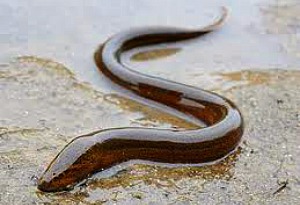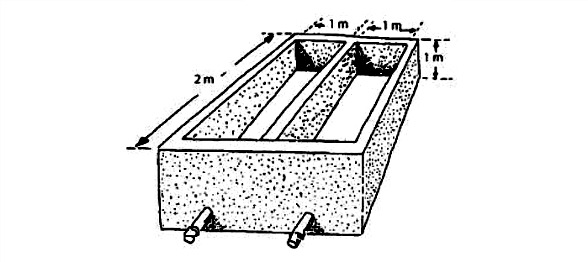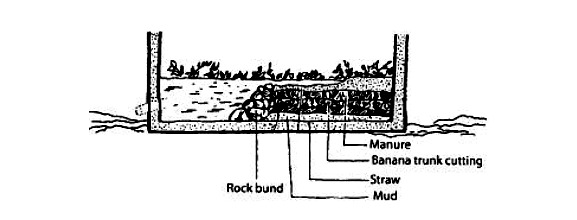 Rice Eel or Monopterus albus is a freshwater eel-like fish belonging to the Synbranchidae family. It is popularly known as “igat” or “palos” here in the Philippines. This family is native to the fresh, brackish, tropical, and subtropical waters of Asia, but is now present in West Africa and North, Central and South America.
Rice Eel or Monopterus albus is a freshwater eel-like fish belonging to the Synbranchidae family. It is popularly known as “igat” or “palos” here in the Philippines. This family is native to the fresh, brackish, tropical, and subtropical waters of Asia, but is now present in West Africa and North, Central and South America.
Monopterus albus has a scaleless cylindrical snake-like body with tapered tail and small eyes. It grows to a meter or less, usually 25 to 40 cm as an adult. Its body color is brown or green-brown above and white or light-brown below. In adults, paired fins are lacking, and the dorsal, caudal and anal fins are reduced. Through its life, Monopterus albus develops a small top fin near its rear. The gill openings are merged into a single slit underneath the head while the mouth is large and protractile and both upper and lower jaws have tiny teeth for eating fishes, worms, crustaceans, and other small aquatic animals at night.
The preferred environment for Monopterus albus or Rice eel includes a wide variety of freshwater-like shallow wetlands, stagnant waters, marshes, streams, rivers, ditches, canals, lakes, reservoirs, and ponds. While they prefer freshwater, they are also able to tolerate brackish and saline conditions.
Monopterus albus or Rice eel culture can be done with a minimum investment, using locally available and cheap resources. The system of raising eels can also be made environment-friendly. It was introduced by the International Institute of Rural Reconstruction (IIRR) in the late 80’s. Many farmers are raising this species for food.
The genus Monopterus albus has six species and are found only in Asia. The rice field eels is worth raising in cemented tanks. The advantages of raising this species are:
- it can be raised in small cemented tanks;
- it can be breed in captivity without using any chemical stimuli;
- it is an air-breathing species and can survive in oxygen depleted conditions, therefore is very useful for areas where there is scarcity of water; and
- its natural food are fish, snails, aquatic insects, invertebrates, worms, etc.
Tanks Preparation and Stocking
1. Make sure that there is enough available natural or clean water. The source of water could be ground water or spring water. Water from domestic faucets can also be used provided the chlorine content is not very high or can be lowered by some mechanisms (spraying or holding the water in storage tanks.)

2. Construct twin tanks 1M x 2M x 1M in size with a total surface area of 4 sqm. The tank should be leak-proof with an outlet at the bottom.

3. Layer half of the tank lengthwise
- the first (bottom) should be mud (preferably from rice fields or ponds) and is 10 cm thick
- the second is composed of straw which should be previously cured for about a week and 10cm thick
- the third is comprised of finely-chopped banana trunks which are cut a week prior to introduction and must be 10cm thick
- the fourth constitutes cow or carabao manure, also 10 cm thick
- the fifth and top layer is mud placed in slope with one end higher than the other
- This layering is good only for Monopterus eels. Aguillan, the local variety found in the rivers in Cagayan (Aparri) and Mindanao (Cotabato), can be raised using the same strategy, but the tanks should not have mud.

4. Introduce water into the tank, 15 cm above the top layer.
5. Allow the materials to decompose for about a week. This is apparent with the production of a foam.
6. Drain the water out and introduce fresh water again. Repeat this process every week for 20-25 days until no more froth appears.
7. Introduce tilapia or carp fingerlings to check if the tank is ready for culturing eels.
8. Allow the fingerlings to stay inside the tank for three days, if they do not die, that means the tank is ready for the introduction of eels. The tank, which is ready, will have a similar quality to a rice field.
9. Before the introduction of eels, plant aquatic plants such as water hyacinth or kangkong on the top soil. The plants will provide shelter for the eels from direct sunlight and also act as a hiding place.
10. For the tank size mentioned, introduce 195 to 200 eels with a ratio of 140 females and 60 males.
Feeding Management
1. Maintain proper feeding levels throughout the culture period.
- Remember: Monopterus albus is a progynus (female first) species. The ones that are below 40 cm are females and those above 60 cm are males. The in-between length group turns cannibal
- Segregate the fingerlings which cling to the water hyacinth roots. Take out the weed and tap it over a net. The fingerlings will fall down Repeat for a few days until there are no more fingerlings left in the tank. Maintain in a separate tank or aquarium until they are pencil size. Then, transfer to a new tanks.
2. Use only mud from the pond in case of a nursery pond until the hatchings develop into fingerlings.
3. Add flour or vitamin pre-mix to the eel’s natural food to make the consistency of stiff paste (so that the food does not dissolve in water and spoil the water quality).
4. Give food individually or in combination of two or more. A natural food, such as fingerlings of other cheaper fish, is the most preferable food.
5. At fingerlings stage, feed eels with a lot of aquatic insect which can be produced naturally in stagnant water bodies.
6. Collect garden snails from the rice fields to reduce snail population eating rice and feed to the eels
7. Consider the following factors in feeding the eels:
- size (length) of the fish;
- total weight of the biomass (all fishes in total); and
- climatic conditions, such as atmospheric temperature
An ideal temperature for eel to feed properly would be between 20-35°C.
Eel’s Natural Food
- fish fingerlings
- earthworms
- snails
- aquatic insects
- silkworm pupae
- slaughter house wastes (cow, carabao, chicken liver, intestine, chicken skin, etc.)
Tip: Silkworm pupae, if available locally, is an excellent food for the eels. Live earthworms can be given directly to the fish. They can also be ground in the form of paste along with other fish and/or snails.
Tips on Feeding
- Always feed the eels at a fixed feeding point and time
- Eels can be fed in trays made out of local materials. The feeding trays should be removed a couple of hours after each feeding. The trays should be designed in such a way that there is minimum or no spilling of the food in the water. Leftover food will deteriorate the water quality. Siphon leftovers using a PVC pipe.
- To begin with, the feed should be placed at the bottom of the tank and then gradually moved to the surface within a span of few days.
- If the eels feed on the surface, observe them everyday from any diseases or strange behavior.
- If dried feeds are used, grind them into powder or paste using a domestic type grinder. It facilitates the storage of food for longer periods.
Harvesting and Transporting
1. Harvest according to the needs of the market and the growth of eels.
2. Harvest partially or completely. If you have more than one tank, harvest completely so that the next lot is ready in the new tank before harvesting.
3. Harvest during feeding time when a net can be placed under the feed.
4. Make sure not to injure the eels as it may, besides causing death, lower the price in the market.
5. Starve the eels in holding tanks before transporting live to the market.
6. Clean the tanks properly after harvesting and sun-dry for a few days before stocking new eels.
Economic Benefits
There being no established market for Monopterus eels, this economic feasibility is based on existing market of local variety of eels, the Anguilla species (locally knows as igat, palos or casili).
For an initial fixed investment of P6,300 and a production of P5,590, a farmer can obtain a net return of P14,410 per eight months or P1,801.25 per month.
Ecological Implications
Some farmers who have introduced Monopterus eels in their rice fields have noticed a marked reduction in the snail population as these are natural feed for the eels. However, some farmers have come across the problem of dike boring by eels, thus making it difficult for them to retain water in their rice fields. The ecological implications of these species is the wild are being studied. It is therefore recommended to raise eels only in cemented tanks and not let them get into natural systems.
Rice fields eels, once introduced into the rice fields, can serve as predator against golden snails which have become a pest in some Asian countries, particularly the Philippines and Vietnam.
Earthworm can be cultured in backyards (Vermiculture) and can be used as supplementary feed for the eels. The compost produced by the worms can be used as fertilizer for vegetable gardens. The eels in rice fields also reduce the amount of insect pests thus increasing the rice production.
For more information contact:
DEPARTMENT OF AGRICULTURE
D.A. Compound, Elliptical Rd.,
Diliman,Quezon City, Philippines
Tel: (02) 8928-8741 to 64 / (02) 8273-2474
Website: www.da.gov.ph
Facebook Page (This link will open on a new window)
Sources: tlrc.gov.ph, Wikipedia.org; Photo: noeyeddeer.com